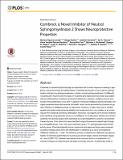Cambinol, a novel inhibitor of neutral sphingomyelinase 2 shows neuroprotective properties
Abstract
Ceramide is a bioactive lipid that plays an important role in stress responses leading to apoptosis, cell growth arrest and differentiation. Ceramide production is due in part to sphingomyelin hydrolysis by sphingomyelinases. In brain, neutral sphingomyelinase 2 (nSMase2) is expressed in neurons and increases in its activity and expression have been associated with pro-inflammatory conditions observed in Alzheimer’s disease, multiple sclerosis and human immunodeficiency virus (HIV-1) patients. Increased nSMase2 activity translates into higher ceramide levels and neuronal cell death, which can be prevented by chemical or genetic inhibition of nSMase2 activity or expression. However, to date, there are no soluble, specific and potent small molecule inhibitor tool compounds for in vivo studies or as a starting point for medicinal chemistry optimization. Moreover, the majority of the known inhibitors were identified using bacterial, bovine or rat nSMase2. In an attempt to identify new inhibitor scaffolds, two activity assays were optimized as screening platform using the recombinant human enzyme. First, active hits were identified using a fluorescence-based high throughput compatible assay. Then, hits were confirmed using a 14C sphingomyelin-based direct activity assay. Pharmacologically active compounds and approved drugs were screened using this strategy which led to the identification of cambinol as a novel uncompetitive nSMase2 inhibitor (Ki = 7 μM). The inhibitory activity of cambinol for nSMase2 was approximately 10-fold more potent than for its previously known target, silence information regulator 1 and 2 (SIRT1/2). Cambinol decreased tumor necrosis factor-α or interleukin-1 β-induced increases of ceramide and cell death in primary neurons. A preliminary study of cambinol structure and activity allowed the identification of the main structural features required for nSMase2 inhibition. Cambinol and its analogs may be useful as nSMase2 inhibitor tool compounds to prevent ceramide-dependent neurodegeneration.
Citation
Figuera-Losada , M , Stathis , M , Dorskind , J M , Thomas , A G , Bandaru , V V R , Yoo , S-W , Westwood , N J , Rogers , G W , McArthur , J C , Haughey , N J , Slusher , B S & Rojas , C 2015 , ' Cambinol, a novel inhibitor of neutral sphingomyelinase 2 shows neuroprotective properties ' , PLoS One , vol. 10 , no. 5 , e0124481 . https://doi.org/10.1371/journal.pone.0124481
Publication
PLoS One
Status
Peer reviewed
ISSN
1932-6203Type
Journal article
Description
This work was supported by National Institute of Mental Health grants: P30 MH075673-06 to BSS, CR, NJH and JCM; R01 MH096636 and R01 MH077542 to NJH (http://projectreporter.nih.gov/reporter.cfm); and The Johns Hopkins Brain Science Institute to BSS.Collections
Items in the St Andrews Research Repository are protected by copyright, with all rights reserved, unless otherwise indicated.

